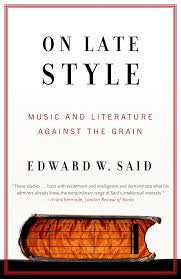Glenn Gould’s distinction as a late-twentieth-century phenomenon
Reading: On Late Style: Music and Literature Against the Grain (2006) by Edward Said
[….] The point about Gould is that he seems to have gripped the general imagination and stays there still, more than two full decades after his death. He was the subject of an intelligent feature film, for example, and has turned up often in essays and fiction in quite unusual ways: in Joy Williams’s "Hawk," for example, and Thomas Bernhard’s The Loser (Der Untergeher). Records and videos by and about him still keep coming out and selling: his first record of the Goldberg Variations was included in a list of the century’s ten best recordings by Gramophone magazine, and a steady number of biographies, studies, and analyses of him as pianist, composer, and theoretician appear with noticeable attention taken of them in the mainstream, as opposed to specialized, media. To most people, he almost stands for Bach, more so even than extraordinary figures like Casals, Schweitzer, Landowska, Karl Richter, and Ton Koopman. It is worth our while, I think, to explore Gould’s connection with Bach, and to try to understand how his lifelong association with the great contrapuntal genius establishes a unique and interestingly plastic aesthetic space essentially created by Gould himself as intellectual and as virtuoso.
What I don’t want to lose sight of in these reflections, however, is that first and foremost Gould was always able to communicate a very high degree of pleasure not only in what he did as performer and personality but in the kind of intellectual activity his life and oeuvre seem endlessly capable of stimulating. As we shall see, this is in part a direct function of his unique virtuosity, which I shall try to elucidate, and in part also the result of its effects. Unlike the digital wizardry of most others of his class, Gould’s virtuosity was not designed simply to impress and ultimately alienate the listener/spectator but rather to draw the audience in by provocation, the dislocation of expectation, and the creation of new kinds of thinking based in large measure on his reading of Bach’s music. I adapt the phrase "new kinds of thinking" from Maynard Solomon’s magisterial reflection on what Beethoven inaugurated in composing the Ninth Symphony—that is, a search not only for order but for new modes of apprehension, and even a new system of mythology in Northrop Frye’s sense of the term. Gould’s distinction as a late-twentieth-century phenomenon—his years of activity, including the period after he left the concert platform in 1964, began in the mid-1950s and ended with his death in 1982—is that almost single-handedly he invented a genuinely challenging and complex intellectual content, what I have just called new modes of apprehension, for the activities of the virtuoso performer, which I believe he remained all of his adult life. I do not think, however, that it is necessary to know all this about what Gould was up to in order to enjoy him as so many people still obviously do: yet the better one can comprehend the general nature of his overall achievement and mission as an altogether unusual type of intellectual virtuoso, the more interestingly rich that achievement will appear.
On Late Style: Music and Literature Against the Grain (2006) by Edward Said



